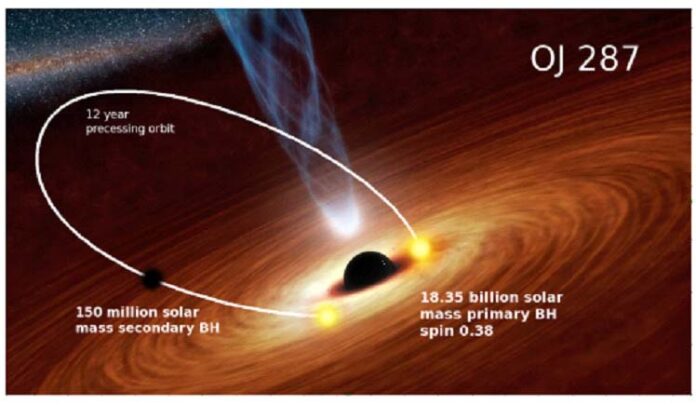NASA: s infra-red observatory Spitzer has recently observed the flare from gigantic binary svart hål system OJ 287, within the estimated time interval predicted by the model developed by astrophysicists. This observation has tested different aspects of General Relativity, the “No-hair theorem”, and proved that OJ 287 is indeed a source of infra-red Gravitationsvågor.
Smakämnen EGT 287 galax, situated in Cancer constellation 3.5 billion light years away from Earth, has two svarta hål – the larger one with over 18 billion times the massa of the Sun and orbiting this is a smaller svart hål with about 150 million times the solar massa, and they form a binary svart hål system. While orbiting the larger one, the smaller svart hål crashes through the enormous accretion disk of gas and dust surrounding its larger companion, creating a flash of light brighter than a trillion stjärnor.
Ju mindre svart hål collides with the accretion disk of the larger one twice in every twelve years. However, due to its irregular oblong bana (called quasi-Keplarian in the mathematical terminology, as shown in the figure below), the flares can appear at different times – sometimes as little as one year apart; other times, as much as 10 years apart (1). Several attempts to model the bana and predicting when flares would happen were unsuccessful until in 2010, when astrophysicists created a model that could predict their occurrence with an error of about one to three weeks. The accuracy of the model was demonstrated by predicting the appearance of a flare in December 2015 to within three weeks.
Another important piece of information that went into the making of a successful theory of binary svart hål system OJ 287 is the fact that supermassive svarta hål can be sources of gravitationsvågor – which has been established after the experimental observation of the gravitationsvågor in 2016, produced during the merging of two supermassive svarta hål. OJ 287 has been predicted to be the source of infra-red gravitationsvågor (2).

In 2018, a group of astrophysicists provided an even more detailed model, and claimed to be able to predict the timing of future flares to within few hours (3). According to this model, the next flare would occur on July 31, 2019 and the time was predicted with an error of 4.4 hours. It also predicted the brightness of the impact-induced flare to take place during that event. The event was captured and confirmed by NASA: s Spitzer Utrymme Telescope (4), which retired in January 2020. To observe the predicted event, Spitzer was our only hope since this flare could not be seen by any other telescope on the ground or in Earth’s bana, as the Sun was in Cancer constellation with OJ 287 and Earth being on opposite sides of it. This observation also proved that OJ 287 emits gravitationsvågor in the infra-red wavelength, as predicted. According to this proposed theory the impact-induced flare from OJ 287 is expected to take place in 2022.
Observationerna av dessa bloss sätter en begränsning på "Inget hårteorem” (5,6) which states that while svarta hål don’t have true surfaces, there is a boundary around them beyond which nothing – not even light – can escape. This boundary is called the event horizon. This theorem also postulates that the matter which forms a black-hole or is falling into it “disappears” behind the svart hål event horizon and is therefore permanently inaccessible to external observers, suggesting that svarta hål have “no hair”. One immediate consequence of the theorem is that the svarta hål can be characterized completely with their massa, electric charge and intrinsic spin. According to some scientists, this outer edge of the black-hole, i.e. the event horizon, could be bumpy or irregular, thus contradicting the “No hair theorem”. However, if one has to prove the correctness of the “No hair theorem”, the only plausible explanation is that the uneven mass distribution of the large black-hole would distort the plats around it in such a manner that it would lead to a change of path of the smaller svart hål, and in turn change the timing of the black hole’s collision with the accretion disk on that particular bana, thus causing a change in the time of appearance of the flares observed.
Som kan förväntas, svarta hål are hard to probe. Hence, as we move forward, many more experimental observations regarding svart hål interactions, with the surroundings as well as with other black holes, are to be studied before one can confirm the validity of the “No hair theorem”.
***
Referenser:
- Valtonen V., Zola S., et al,. 2016, "Primärt svarthålssnurr i OJ287 som fastställts av General Relativity centenary flare", Astrophys. J. Lett. 819 (2016) nr 2, L37. DOI: https://doi.org/10.3847/2041-8205/819/2/L37
- Abbott BP., et al,. 2016. (LIGO Scientific Collaboration and Virgo Collaboration), "Observation of Gravitational Waves from a Binary Black Hole Merger", Phys. Rev. Lett. 116, 061102 (2016). DOI: https://doi.org/10.1103/PhysRevLett.116.061102
- Dey L., Valtonen MJ., Gopakumar A. et al, 2018. "Authenticating the Presence of a Relativistic Massive Black Hole Binary in OJ 287 Using Its General Relativity Centenary Flare: Improved Orbital Parameters", Astrofys. J. 866, 11 (2018). DOI: https://doi.org/10.3847/1538-4357/aadd95
- Laine S., Dey L., et al, 2020. "Spitzer Observations of the Predicted Eddington Flare från Blazar OJ 287". Astrophysical Journal Letters, vol. 894, nr 1 (2020). DOI: https://doi.org/10.3847/2041-8213/ab79a4
- Gürlebeck, N., 2015. "No-Hair Theorem for Black Holes in Astrophysical Environments", Fysiska granskningsbrev 114, 151102 (2015). DOI: https://doi.org/10.1103/PhysRevLett.114.151102
- Hawking Stephen W., et al 2016. Mjukt hår på svarta hål. https://arxiv.org/pdf/1601.00921.pdf
***






































